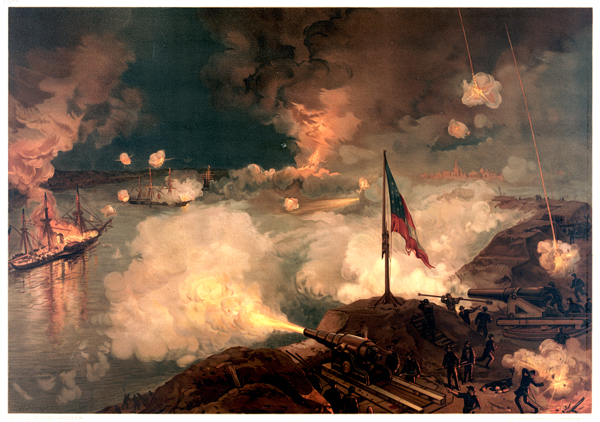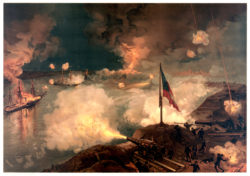Siege of Port Hudson
The capture of Port Hudson in Louisiana gave Union forces control of the Mississippi River and was a significant turning point in the Civil War.

Courtesy of Library of Congress Prints and Photographs Division
Battle of Port Hudson. Unidentified
The siege and subsequent surrender of the Confederate garrison at Port Hudson in June and July of 1863 remains one of the most under-appreciated turning points of the Civil War. Not only did the bastion’s fall eliminate the Confederacy’s control over the flow of naval and commercial traffic on the Mississippi River, the fight for this strategic position brought about important transformations in the overall conduct of the war.
Located just twenty-five miles upriver from Baton Rouge, the town of Port Hudson sprang into existence during the antebellum period to serve as a transit depot for the surrounding countryside’s booming trade in cotton and sugar. The completion of a short rail line to nearby Clinton, Louisiana, in 1833 only increased the flow of trade at the hamlet’s wharves. Despite such activity, however, Port Hudson never truly coalesced into a town, and by the start of the Civil War it retained an almost exclusively commercial character and boasted few permanent residents.
Port Hudson would figure prominently in the greater Confederate defense strategy for the Mississippi River, yet it was not until New Orleans fell to the Union at the end of April 1862 that its role came into focus. So great was the Confederacy’s misplaced confidence in Fort St. Philip and Fort Jackson, near the mouth of the Mississippi, that at the beginning of the conflict many wrongly believed that Port Hudson would eventually be fortified in order to help protect Baton Rouge and New Orleans against an attack from upstream. When these two cities fell unexpectedly to the Union, the Confederates scrambled to fortify Vicksburg, Mississippi, and later, Port Hudson. Holding these two citadels on the Mississippi enabled the Confederacy to retain control over the strategic confluence of the Mississippi and Red Rivers, a supply line of great significance to the southern war effort.
Defense of Port Hudson
In many respects, Port Hudson proved far more defensible than Vicksburg. Not only did it not have a large civilian population to protect and provision, its terrain afforded its defenders greater protection in virtually every direction against attack. Sitting atop eighty-foot bluffs, Port Hudson enjoyed a commanding view of the river and was situated at a sharp 150-degree bend that required vessels to carefully navigate in order to avoid running aground. Any ship that rounded this bend would then be required to expose its vulnerable stern to the Confederate batteries, because the river followed a course that led directly away from the bluff. Natural obstacles made any landward attack against Port Hudson an equally formidable task. Defensive lines ran along a two-mile north-south arc that followed a path dictated by a series of deep ravines or by dense forests or swamps. Indeed, the only level approaches into the hamlet were located along the few roads that led into town and along the rail line between Port Hudson and Clinton.
After Confederate Maj. Gen. John C. Breckinridge failed to retake Baton Rouge in August, 1862, he retreated upriver to Port Hudson. Thus began the fortification of this bastion on the Mississippi, which was, in most respects, of greater strategic value and infinitely more defensible than Breckinridge’s initial objective of Baton Rouge. Construction of effective defensive works at Port Hudson profited immensely when Breckinridge left for the Kentucky campaign and was replaced by Maj. Gen. Franklin Gardner. An 1843 graduate of West Point, Gardner was a particularly gifted engineer and manager of resources. Under his direction, the men of Port Hudson were able to maximize the strength of their consistently undermanned post. The judicious leadership of Gardner and his immediate subordinate, Brig. Gen. William Nelson Rector Beall, did much to inspire confidence and morale among the men of the garrison. These intangible assets would prove crucial in the trying months to come.
Union Forces at Port Hudson
The effective command of Port Hudson’s garrison stood in contrast with the divided, and at times, dubious leadership of those Union forces charged with dislodging the bastion’s Confederate defenders. On the one extreme stood the successful and courageous veteran naval commander, Rear Adm. David Glasgow Farragut, who had boldly run Fort Jackson and Fort St. Philip to capture New Orleans. His army counterpart, Maj. Gen. Nathaniel P. Banks, was substantially less suited to the task of military command. A former congressman, Speaker of the US House of Representatives, and governor of Massachusetts, Banks was a gifted politician. He had also repeatedly demonstrated his ineffectiveness as a general during the first year of war in Virginia, however, and would continue to do so in Louisiana. Banks replaced Maj. Gen. Benjamin Butler in November of 1862 and arrived in New Orleans with orders to eliminate the Confederate threat at Port Hudson.
The first indication that the partnership between Farragut and Banks was unworkable came on March 14, 1863. In a coordinated movement, Banks was to march more than 10,000 men to the outskirts of Port Hudson and make a diversionary attack so that a portion of Farragut’s Gulf Blockading Squadron might more easily pass the powerful Confederate batteries on the bluff. Unfortunately for Farragut’s sailors, Banks failed to attack at all, his inexperienced troops instead listening to the battle rage in the distance. Only Farragut’s flag ship, the Hartford, and an escort managed to pass Port Hudson. Confederate gunners sank one ship, the Mississippi, and inflicted heavy damage on the rest of the squadron, forcing it to retreat downriver for repairs.
Impressed with the Confederate works and overestimating his enemy’s numerical strength by a factor of three, Banks hesitated to attack Port Hudson in the wake of the March 14 action. Instead, the Union commander sought reinforcements from his superiors while recruiting and training a local force of Black troops to help bridge what he believed to be his inferiority in numbers. In reality, at no time during the campaign did Gardner have more than 7,000 men—and often he had far fewer—while Banks consistently enjoyed a force more than double the size of his enemies’. Banks’s delay also allowed Gardner to improve the defenses at Port Hudson and to gather food and ammunition into its works. The manpower-strapped Confederates were not, however, able to materially increase the number of defenders at the garrison.
First Assault
When Banks finally moved his army into position to attack on May 27, he faced a well-entrenched enemy. The Union force also labored under some significant and inescapable handicaps. Many of Banks’s men were ninety-day volunteers whose enlistments would expire at the end of August, and a high proportion of his force had not before seen combat. Exacerbating this problem was a set of ineffective regimental commanders who would prove unreliable in the coming action. The daylong assault went poorly from the beginning. A coordinated advance instead proceeded in piecemeal fashion, and Union soldiers foundered over the difficult terrain. Nightfall found scores of dead and dying northern men laying about the approaches to Port Hudson. During the disastrous attack, Banks had taken 1,995 casualties, including almost 300 fatalities. Gardner’s total casualties numbered 235.
Probably the most significant outcome of the May 27 assault was that it was the first time that Black troops had been used in a meaningful, front-line combat situation. The First and Third Louisiana Native Guards led a late afternoon attack against the extreme Confederate left, a sector characterized by particularly difficult terrain. Like most inexperienced fighting units of citizen soldiers during the conflict, the Native Guards could not expect to accomplish much against a well-entrenched and battle-hardened enemy, but their conduct convinced most observers that Black troops could fight and die just as well as their white compatriots. Widely publicized by the advocates of Black recruits, the deeds of the Native Guards did much to ensure that eventually 180,000 men of color would serve in the Union army and 20,000 in the Union navy.
The bloody repulse sapped morale in Banks’s army and inspired the general to commit to a siege of Port Hudson instead of continuing further attempts at taking the position through frontal assault. By June 1, Union engineers began building breastworks and fortifications, digging sap trenches, and positioning artillery for long-term bombardments. Several miles downriver, Union mortar boats kept up a constant barrage. In the course of the following weeks, Union soldiers and Confederate soldiers and civilians suffered alike. Union troops were poorly provisioned and housed, having come to Port Hudson unprepared for the long stay in the intense heat. Inside Port Hudson, the Confederates found their food reserves dwindling with every passing day. Reduced to eating mules, cats, rats, and marginally nutritious grains, disease and fatigue grew prevalent in the ranks. Such conditions led to waning morale in both armies, but more severely in the Union trenches where the ninety-day men’s enlistments would soon expire. Many of these green recruits began shirking dangerous duty.
Second Assault
Two weeks into the siege, Banks attempted a second assault against the Confederate works. Although the June 14 attack drew nearer to the defenses of Port Hudson, like the one on May 27, it was a costly failure. Banks lost another 1,792 men, including 203 killed in action. The Confederates incurred fewer than fifty casualties. Just as General Ulysses S. Grant had done at Vicksburg, Banks refused to ask for a truce afterward to collect the wounded who had fallen in this assault, which essentially guaranteed more needless death and helped to further depress morale.
A boat finally arrived on July 7 bringing news of the recent surrender of Vicksburg. With its capitulation, continued Confederate resistance at Port Hudson was pointless. Moreover, a lack of munitions and food meant that defeat was inevitable within a matter of days. Two days later, on July 9, Gen. Gardner surrendered the garrison. Enlisted Confederates were granted their parole almost as soon as the paperwork could be processed. Many of these men left the war permanently. The Confederate officers at Port Hudson, however, were taken prisoner and sent to Memphis or New Orleans to await exchange. A large number of these officers would spend the rest of the war in prisoner-of-war camps in the North.
The siege at Port Hudson officially lasted forty-eight days, earning the dubious distinction as the longest prolonged siege in American military history. More important, the positive reputation of the Black troops who participated opened the door to wider participation by formerly enslaved men and the crucial social transformations that their service brought about.
